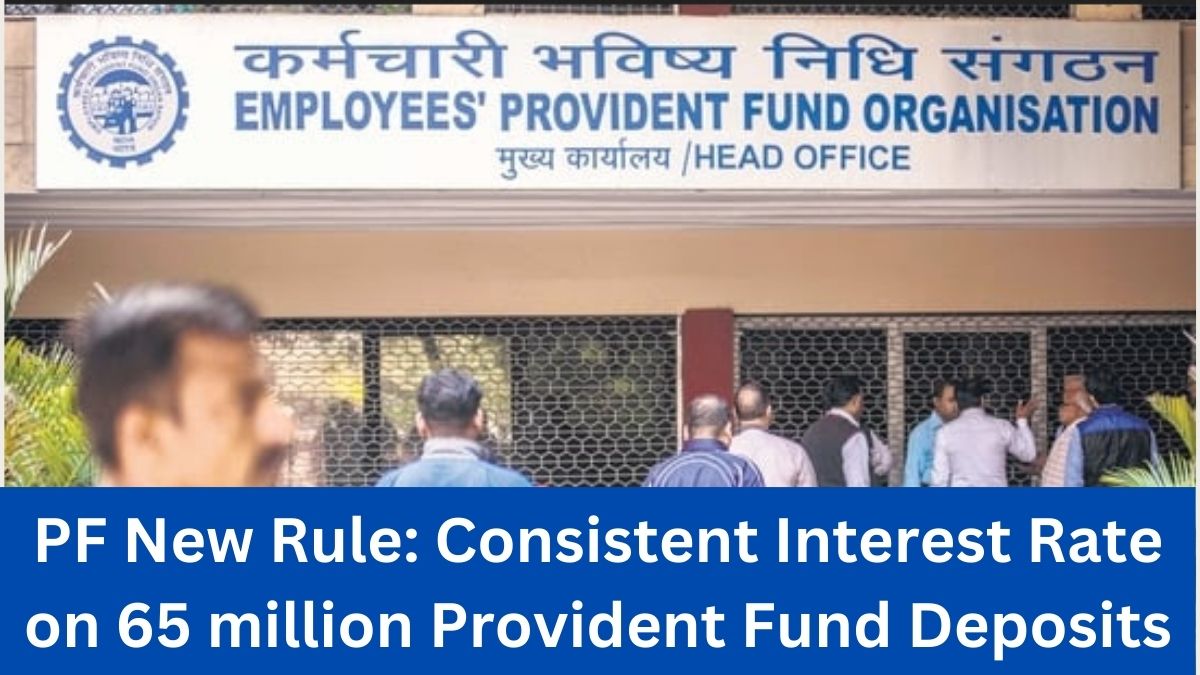The Employees’ Provident Fund Organisation (EPFO) is actively considering measures to ensure a stable interest rate for its subscribers by creating an Interest Stabilization Reserve Fund. This move aims to protect 65 million provident fund (PF) subscribers from market fluctuations that impact interest rates.
A recent report suggests that the Ministry of Labour and Employment has commissioned an internal study to explore the feasibility of this initiative. If implemented, the new framework will ensure that EPFO members receive consistent returns, regardless of the actual earnings generated by the organization’s investments.

Understanding the EPFO Interest Stabilization Reserve Fund
The core objective of the proposed Interest Stabilization Reserve Fund (ISRF) is to offer a safeguard against volatile financial markets. The fund will act as a buffer to counterbalance fluctuations in investment returns, ensuring that EPFO subscribers receive a predictable and stable interest rate annually.
How Will the Interest Stabilization Fund Work?
The mechanism behind the interest stabilization reserve fund is designed to minimize the impact of market volatility on the interest rates of provident fund deposits. Here’s how it will function:
- Surplus Allocation: EPFO will set aside a portion of the surplus earnings it generates from investments every year.
- Reserve Fund Creation: The accumulated surplus will be stored in a reserve fund, which can be utilized when investment returns decline in a particular year.
- Interest Rate Stabilization: If the investment income falls below a sustainable level, EPFO will draw from this reserve fund to maintain a consistent interest rate for its members.
- Protection from Disproportionate Cuts: The system will prevent sudden and disproportionate reductions in interest rates that could negatively affect subscribers.
Impact of Market Fluctuations on EPFO Interest Rates
EPFO generates interest by investing in a variety of financial instruments, including:
- Government securities
- Corporate bonds
- Exchange-Traded Funds (ETFs)
- Other approved financial instruments
The returns from these investments directly influence the annual PF interest rate. If the market performs poorly, the interest rate might decline, whereas strong market performance results in higher returns. The proposed Interest Stabilization Fund will mitigate this uncertainty and offer more predictable earnings to subscribers.
Historical Trends in EPFO Interest Rates
The interest rates provided by EPFO have witnessed fluctuations over the decades. Below is a historical comparison of EPFO rates:
| Financial Year | Interest Rate (%) |
|---|---|
| 1952-53 | 3.0 |
| 1989-90 | 12.0 (Highest) |
| 2000-01 | 12.0 |
| 2001-02 | 9.5 |
| 2021-22 | 8.1 |
| 2022-23 | 8.15 |
| 2023-24 | 8.25 |
When Will the New EPFO Rule Be Implemented?
The proposal is still in its preliminary stages, and detailed deliberations are ongoing. According to reports, the implementation of the interest stabilization reserve fund is expected to take place by the financial year 2026-27.
The decision rests with the Central Board of Trustees (CBT), the highest governing body of EPFO, headed by the Minister of Labour and Employment. The board is likely to finalize and approve the framework before official implementation.
Benefits of the Interest Stabilization Reserve Fund for EPFO Members
The introduction of an Interest Stabilization Fund will offer several advantages to EPFO subscribers, including:
- Predictable and stable returns on PF deposits.
- Reduced dependency on market performance to determine interest rates.
- Financial security for long-term savings and retirement planning.
- Protection from steep interest rate declines during economic downturns.
Potential Challenges and Considerations
While the idea of a stabilized interest rate sounds promising, there are some challenges that EPFO may need to address:
- Sufficient Surplus Accumulation: The fund’s effectiveness depends on consistent surplus generation, which might not always be possible.
- Fund Management: Ensuring transparent and efficient fund utilization will be critical.
- Approval Process: The government and relevant stakeholders will need to approve and regulate the framework before implementation.
Frequently Asked Questions
1. What is the purpose of the EPFO Interest Stabilization Reserve Fund?
The Interest Stabilization Reserve Fund is designed to maintain stable interest rates for EPFO subscribers, ensuring predictable returns despite market fluctuations.
2. When will the new EPFO rule come into effect?
The initiative is currently under discussion, with implementation expected by 2026-27, subject to approval by the Central Board of Trustees.
3. How does EPFO decide its interest rates?
EPFO determines interest rates based on returns from investments in government securities, corporate bonds, and equity markets.
4. Will this new rule benefit all EPFO subscribers?
Yes, the stabilization fund will benefit all 65 million EPFO members by protecting them from drastic interest rate fluctuations.
5. Can the interest rate still change despite the stabilization fund?
While the fund aims to reduce extreme fluctuations, minor variations may still occur based on investment performance and economic conditions.
The EPFO’s proposal to introduce an Interest Stabilization Reserve Fund marks a significant step toward providing financial security to its subscribers. If successfully implemented, this initiative will help millions of employees receive consistent and predictable returns on their provident fund deposits. With deliberations ongoing, the final approval and execution are expected in the coming years, offering a much-needed shield against market volatility.
Click here to know more.
Kishan is a knowledgeable writer specializing in agriculture and the latest government job recruitments, delivering clear and insightful content to inform and empower readers.
